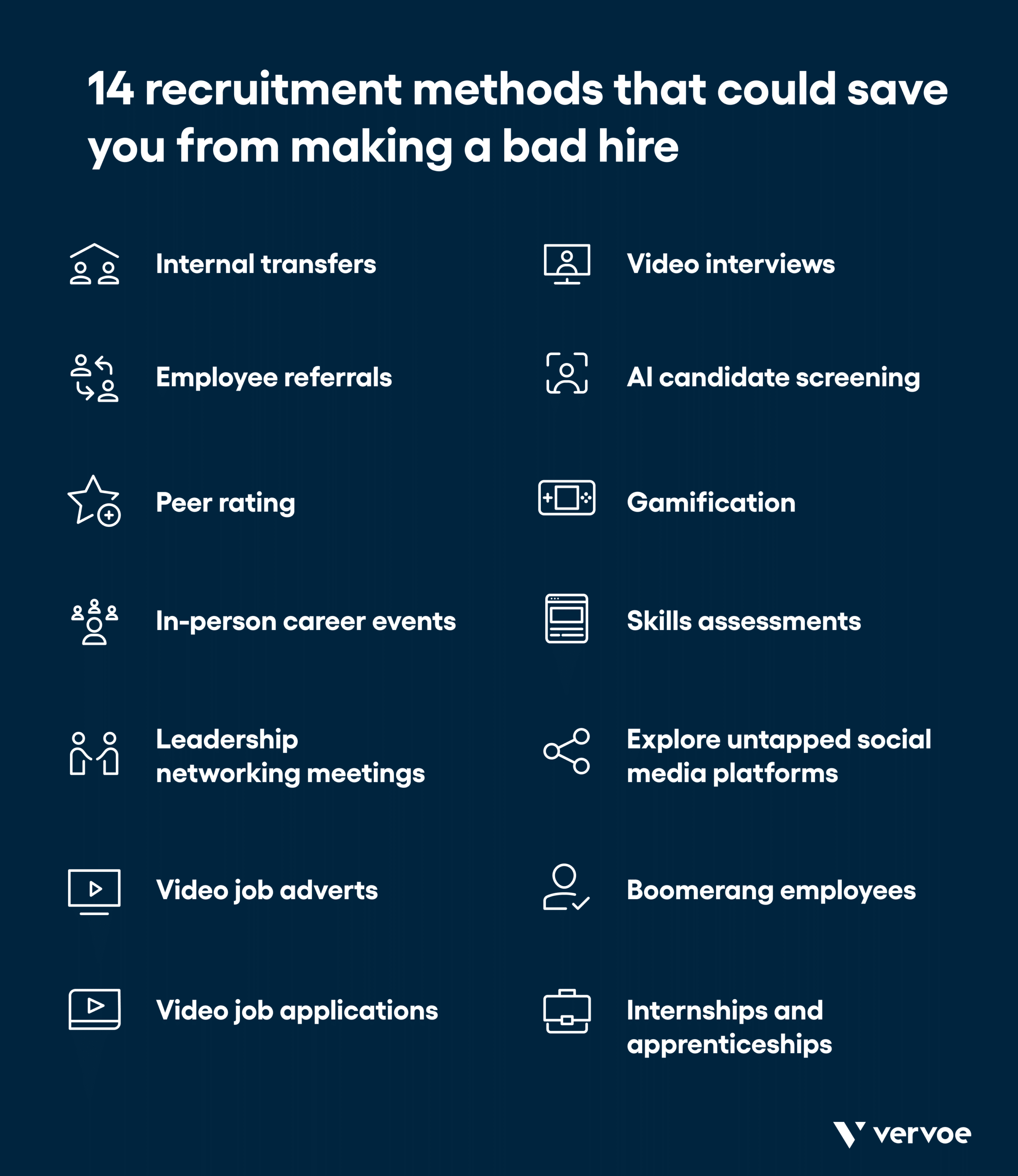According to CareerArc’s 2021 Future of Recruiting Study, 76% of companies believe that in 2021 hiring demand will approach, return to, or even exceed pre-pandemic levels.

With that in mind, employers must review their hiring processes and look to implement a range of recruitment methods to attract, recruit, and retain top talent in 2021 and beyond.
What is a recruitment method?
Recruitment methods refer to the different strategies adopted by hiring managers or recruiters to source and assess suitable job candidates.
The more creative and innovative the different methods of recruitment are, the easier it becomes for employers to unearth hidden talent, build a diverse workforce, improve retention rates, drive efficiencies, and reduce costs.
Job recruitment methods fall into several categories, which include internal recruitment, external recruitment, online recruitment, and offline recruitment. Below, we outline the benefits of each and list some of the most effective emerging strategies that organizations are using today.
Internal vs external recruitment methods
There are pros and cons to both internal and external methods of recruitment. But the best recruitment methods for your organization will depend on several factors including the role you need to fill, the level of seniority, and your time constraints.
Internal recruitment describes the process of hiring candidates from within your organization. This process is typically much more efficient because there’s no need to onboard or screen candidates or wait around for new hires to fulfill long notice periods.
In addition, by recognizing and rewarding existing employees you develop a workforce that feels valued, appreciated, and motivated.
On the other hand, internal candidates may bring less creativity to the table. They might be too comfortable with the way things are done, which means they could be less inclined to challenge your organization’s existing processes. Workplace politics and employee favoritism can also unfairly influence internal hiring decisions.
External recruitment describes the process of hiring candidates from outside your organization. Hiring externally means gaining access to a wider and more diverse talent pool, which is particularly useful if you’re looking to recruit for a highly specialized position. External candidates will also bring new perspectives and ideas, helping your organization to stay competitive.
The main drawback of external recruitment is that it is expensive and time-consuming. You’ll likely need to pursue multiple avenues to identify suitable candidates and the reference-checking, vetting, and onboarding processes will be a lot more rigorous.
Online vs offline recruiting
As with internal vs external recruiting, online and offline recruitment methods in hr each provide unique benefits depending on your organization’s needs and priorities.
Online recruitment sees organizations use a range of internet-based solutions to source and assess suitable job candidates. This is a quick and cost-effective way to identify talent and process applications from a large talent pool across multiple geographies. Automation and artificial intelligence (AI) can be implemented to screen and communicate with large volumes of applicants, driving further efficiencies. Online recruitment methods are often much more convenient for both the employer and applicant but the main downside is that the process is less personal.
Offline recruitment describes any hiring methods that do not use the internet, with candidates being sourced and assessed through more traditional marketing methods via high-visibility channels.
The human connection that organically accompanies offline recruitment methods enables hiring managers and recruiters to develop more meaningful relationships with prospective candidates. Not only can this help you to unearth hidden talent, but it increases your chances of finding someone who is the perfect fit for the role and will assimilate well into your workplace.
It takes time and commitment to build a rapport and trust with candidates but, in exchange, you’ll have the opportunity to properly communicate the benefits of the role and your organization, and ultimately give them an offer they can’t refuse.
14 recruitment methods that could save you from making a bad hire
Trawling through LinkedIn, reviewing cover letters, hosting networking meetings, and posting on job boards are trusty and important recruitment methods used by employers.
However, it’s certainly worth diversifying your approach to sourcing talent by embracing some of the more creative recruitment techniques out there. Here are 14 popular or emerging methods of recruiting staff that might just save you from making a bad hire.
1. Internal transfers
A good way to overcome the limitations of internal hiring is to extend your search to include employees who work in different functions or geographies.
Top talent at your organization will likely be eager to pursue new and exciting opportunities, whether it’s transferring overseas to take on a management role or making a lateral move into a different department to learn new skills and further advance their career.
Ensuring that the most driven among your workforce are continually challenged and motivated is also a useful retention strategy.
2. Employee referrals
If you’re proud of your current employees, it makes sense to trust their judgment when it comes to hiring the best talent for your organization.
By implementing an employee referral scheme you essentially pass the baton of pre-screening candidates to your existing workforce, reduce your time to hire, and elevate your chances of recruiting people who will be a good culture fit.
You can incentivize employees to submit referrals by offering benefits, such as a bonus, for each successful hire.
3. Peer rating
Much like employee referral schemes, peer rating puts responsibility in the hands of your workforce.
Establishing a feedback process that encourages all employees to regularly review their peers is a great way to identify your highest achievers and gain a better understanding of an employee’s overall performance. If someone is performing well independently but struggles to work as part of a team, peer reviews will likely highlight this issue. The information you gain from peer rating can inform your future internal recruitment decisions.
4. In-person career events
COVID-19 certainly accelerated the trend towards online recruitment, but that doesn’t mean we’ve witnessed the end of in-person recruitment events.
Being able to meet with candidates face-to-face in an intimate environment is one of the main benefits of hosting an event. You’ll have the opportunity to get to know the candidates who have invested their time and energy to attend your event, answer their questions, and showcase a little more about your organization.
You can connect with many more people via an online hiring event, but you might attract a handful of perfect candidates to your in-person event.
5. Leadership networking meetings
In the hunt for top talent, it would be remiss not to leverage your own network. Your peers in other industries, geographies, and organizations have invested time making useful connections and growing their networks, and one of them could provide you with access to a dream candidate.
Consider scheduling a regular meeting with a trusted inner circle of leaders and hiring managers, whether it’s an in-person coffee meet-up or a video conference. This dedicated time provides the opportunity for attendees to share details about their current job openings in exchange for advice, recommendations, and introductions. At the very least, this is an opportunity to expand your network.
6. Video job adverts
In a competitive and candidate-driven job market, your organization needs to stand out from the crowd. The most highly skilled and desirable candidates expect brands to sell themselves and because first impressions matter so much, this includes creating exciting and enticing job advertisements.
Video job adverts, in particular, are gaining in popularity because they are engaging, memorable, offer an easy way to communicate your brand’s values and story, and can reach a lot of people in a short space of time. Candidates would much prefer to watch an entertaining two-minute video, which showcases your organization’s culture or introduces existing employees than to read through multiple pages on your website.
7. Video job applications
Traditional resumes, cover letters, and questionnaires serve a purpose, but it’s often hard to pinpoint a stand-out application in a sea of hundreds or even thousands.
If your organization is pursuing the online recruiting route, requesting that candidates submit a video application for the first stage of recruitment is a brilliant way to make the process a bit more human. Candidates will be able to showcase more of their personality, demonstrate their enthusiasm for a role, and highlight the most relevant information from their CV, making the initial screening process much less overwhelming.
8. Video interviews
Video interviewing provides the same benefits as a video application, and then some. Most crucially, eliminating in-person interviews can drastically reduce your time to hire and reduces the risk of you missing out on top talent. It’s much easier to schedule time with candidates and there’s no need for them to commute to your workplace.
In addition, recruiters and hiring managers are more likely to create a consistent format for interviewing via video conference, which helps when it comes to distinguishing between similarly qualified candidates and reducing unconscious bias.
Unstructured interviews, which allow individual hiring managers or recruiters to determine the format and contents of an interview are not only unfair but also often result in bad hires.
9. AI candidate screening
Organizations are increasingly leveraging AI and automation to streamline their recruitment process. This includes automated sourcing, screening, and candidate communication, chatbots that can answer candidate questions or schedule interviews, and AI tools that will predict a candidate’s likelihood to succeed in a role.
Technologies like these can drive efficiency, improve the quality of hires, provide a better candidate experience, and eliminate unconscious bias.
10. Gamification
Automation will soon be a fundamental part of every organization’s recruitment process and, without the heavy burden of repetitive and time-consuming tasks, recruiters and hiring managers will have much more freedom to be creative.
Gamification is one way to shake up the recruitment process to make it more fun for candidates and increase the chances of making a successful hire. You could host a hackathon, run competitions, or create a game that tests industry knowledge and key skills.
11. Skills assessments
If you’re managing a huge volume of applications, skills testing is a quick and effective way to screen candidates and create a shortlist. Once you’ve determined your hiring priorities, you’ll be able to find a skills assessment tool that works for your organization, whether you’re looking for a candidate with a very specialized skillset, high emotional intelligence (EQ), or the right values.
Skills testing eliminates unconscious bias, reduces time-to-hire, improves retention rates, and makes it easier to distinguish between candidates with similar experience and qualifications.
12. Explore untapped social media platforms
Large-scale jobs boards and sites like LinkedIn are fantastic platforms for advertising job openings and finding talent because they enable you to connect with a lot of people very quickly. However, don’t make the mistake of dismissing smaller or industry-specific online platforms.
It will take some time to seek these out and scour them for suitable candidates, but these sites might be home to the experienced and skilled talent you desire.
13. Boomerang employees
A boomerang employee describes someone who performed well at your organization and eventually left on good terms. Whether they moved locations, accepted a promotion or pay-rise elsewhere, or returned to full-time education, your organization would be lucky to have them back. Their time away from your organization has likely exposed them to new experiences, but you know they understand your company’s culture and its values and will do a good job.
Much like employee referral schemes, boomerang employees reduce your time-to-hire and cost-to-hire and make the onboarding process much simpler.
14. Internships and apprenticeships
Internships or apprenticeships provide job hunters with the opportunity to gain valuable work experience and learn new skills, while employees can evaluate potential candidates in a real-life working environment before offering them a full-time position. These schemes are also a good way to upskill high-potential candidates to prepare them for future roles in your company.
Conclusion
Ultimately, the top recruiting method is entirely dependent on your organization’s needs and priorities, as well as the number of people you are looking to hire. Most likely a hybrid approach that leverages both online and offline recruitment methods, and internal and external recruitment, will help you to source the best talent.























